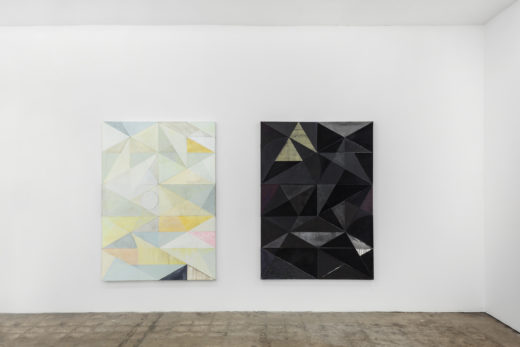- Under the water was sand, then rocks, miles of rocks, then fire

- A JAMBOREE OF HOODLUMS: Wallace Stevens on Miami
Material Catch and Celebrating Opposites
Ivan Shapiro

Michael Conrads, Celebrating Opposites, Mindy Solomon Gallery
JANUARY 21-MARCH 4, 2017
Dominique Labauvie, who lives in Tampa via Strasbourg, makes sculptural works of forged steel that are welded together to form marks in space. In some cases, patina is applied to their surfaces. Although these works are sculptural, they are equally, if not entirely, informed by drawing and line. Those works that are installed directly against the white walls of the Mindy Solomon Gallery resemble large graphite drawings on paper. Cloud 9, a larger example (95 x 43 x 20 inches), is pushed up against the wall in such a way that, at a certain angle, the negative space of its “feet” seems to project a color block defined by the convergence of the white walls and the gray industrial floor.
The works are minimal—stripped of any excess down to pure form. And yet, they are wholly precarious, at all times susceptible to the unknown disintegrative powers of a breath, or a loud echo. Their power lies in the tension that keeps them standing. Like a chest pushed out fully by a deep breath, they stand boasting, on the verge of crumbling or retracting at any moment. Here, we see sculptures not as sculptures, but as drawings, concurrently harnessing the maximum potential of both rigidity and dynamism.
Laubauvie’s sculptures are accompanied by charcoal and pastel sketches of a similar aesthetic, all hung at various heights. Despite their stylistic likeness, the works on paper feel both trapped within the frames and entrapping, while the sculptures encourage interaction, self-measurement.
Michael Conrads’ show, Celebrating Opposites, displays his use of a variety of materials, including various fabrics, acrylics, oil, shellac, bitumen, and pastel. His works explore ideas of transparency, material, and surface, and seem to be characterized by geometry, although his concern lies more prominently in composition and layout. His compositions are first conceived as drawings on grid-lined paper. Some pieces maintain the grid, so as to illuminate this process. It seems that this approach allows Conrads, like Labauvie, to explore different dimensions in space simultaneously. Conrads’s work presents multiple perspectives concurrently—this is how he fleshes out the illusion of depth. Ultimately, out of this seeming chaos arises systems of order, repeated images or shapes, redundant thoughts. In essence, Conrads attempts to negotiate a compromise between these energies to create compositional stability.
The works of Conrads and Labauvie exhibit alternate tensions. Conrads’ seeks balance, while Labauvie’s accepts the unattainability of balance. Conrads’ is rigid and compartmentalized, while Labauvie’s seem organic and exposed. But despite these reversals, an acuity for minimal form persists.
Ivan Shapiro is a writer who lives and works in Miami.









